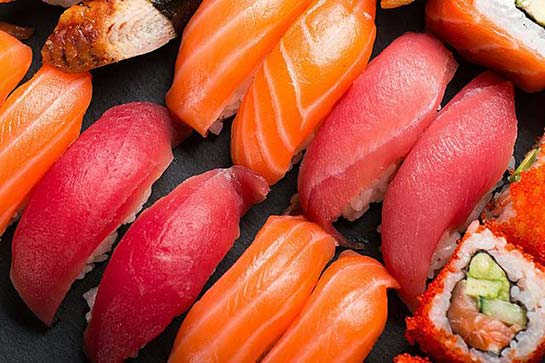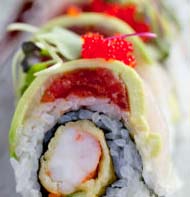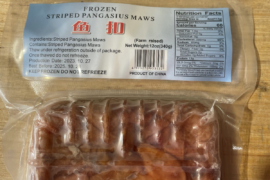According to results from a recently published study conducted by researchers at the University of California at Los Angeles (UCLA) and Loyola Marymount University, 47% of DNA-tested sushi ordered at 26 Los Angeles restaurants from 2012 through 2015 was not correctly labeled.
The findings were publicized just as the outgoing Obama Administration was issuing new rules aimed at preventing unverifiable seafood from entering the United States market. Under the Seafood Import Monitoring Program, which went into effect on January 9, importers are required to report information and maintain detailed records about the harvest and chain of custody of fish they handle.
 “DNA bar coding is becoming an increasingly popular tool to identify mislabeled products,” said LMU biology instructor Demian Willette, the report’s lead author who conducted the study with researchers from UCLA, UC Santa Cruz and UC Santa Barbara. “Our finding of a persistently high rate of seafood mislabeling should encourage consumers to demand strong truth-in-menu laws from local public health agencies.”
“DNA bar coding is becoming an increasingly popular tool to identify mislabeled products,” said LMU biology instructor Demian Willette, the report’s lead author who conducted the study with researchers from UCLA, UC Santa Cruz and UC Santa Barbara. “Our finding of a persistently high rate of seafood mislabeling should encourage consumers to demand strong truth-in-menu laws from local public health agencies.”


“The good news is that sushi represented as tuna was almost always tuna,” Alison Hewitt, senior media relations officer at UCLA, posted at the www.ioes.ucla.edu website. “Salmon was mislabeled only about one in 10 times. But out of 43 orders of halibut and 32 orders of red snapper, DNA tests showed the researchers were always served a different kind of fish. A one-year sampling of high-end grocery stores found similar mislabeling rates, suggesting the bait-and-switch may occur earlier in the supply chain than the point of sale to consumers.”
“Half of what we’re buying isn’t what we think it is,” said Paul Barber, a UCLA professor of ecology and evolutionary biology and senior author of the study that has been published in the journal Conservation Biology. “Fish fraud could be accidental, but I suspect that in some cases the mislabeling is very much intentional, though it’s hard to know where in the supply chain it begins. I suspected we would find some mislabeling, but I didn’t think it would be as high as we found in some species.”
It’s not simply a matter of being annoyed that the wrong species of fish is on your plate. Such economic fraud undermines environmental regulations limiting overfishing, introduces unexpected health risks and interferes with consumers’ decisions, the researchers noted.
“Over the four-year study period, only bluefin tuna was consistently identified correctly,” pointed out Hewitt. “While just one of 48 tuna samples proved to be a different fish, different kinds of tuna occasionally swapped places, including two samples that turned out to be Atlantic bluefin tuna and southern bluefin tuna, species classified as endangered and critically endangered. Out of nine orders of yellowfin tuna, seven were a different kind of tuna, usually bigeye – a vulnerable and overexploited species, the researchers said.”
Only six of 47 salmon orders were mislabeled. However, all halibut and red snapper orders failed the DNA test, and in nine out of 10 cases, consumers ordering halibut were served flounder. About four in 10 halibut orders were species of flounder considered overfished or near threatened.
Although some short-term studies have suggested that fish fraud is declining due in part to stricter regulations, this study uncovered consistent mislabeling year over year, indicating seafood misidentification is not improving. While the current study took place in Los Angeles, previous studies detected similar problems nationwide, suggesting that the recent findings are widely applicable.
“If we don’t have accurate information on what we’re buying, we can’t make informed choices,” Barber said. “The amount of mislabeling is so high and consistent, one has to think that even the restaurants are being duped.”
Who is Responsible for Fraud?
 The National Fisheries Institute (NFI), a McLean, Virginia-based trade association that represents the seafood industry and allied concerns, commented on the study as follows:
The National Fisheries Institute (NFI), a McLean, Virginia-based trade association that represents the seafood industry and allied concerns, commented on the study as follows:
 “It’s an alarming number (47% sushi mislabeling) and it’s not unique from research completed in different cities by other universities, news outlets and NGOs. Fraud is illegal, and reports like this help shine a light on the necessity of regulators to be more stringent about enforcing laws that crack down on this criminal act.
“It’s an alarming number (47% sushi mislabeling) and it’s not unique from research completed in different cities by other universities, news outlets and NGOs. Fraud is illegal, and reports like this help shine a light on the necessity of regulators to be more stringent about enforcing laws that crack down on this criminal act.
“What is also alarming, however, is the suggestion that this research indicates the fraud ‘may occur earlier in the supply chain than the point of sale to consumers.’ That may be the case, but this conclusion is not based on science or the research completed here.
“The study, similar to the previous research in other cities, only completes two out of three steps. To find out where the real fish fraud happened, researchers need:
- A menu showing what the fish is called
- A DNA sample of the fish
- An invoice from the restaurant showing what fish they ordered from a supplier
“If the invoice says the restaurant ordered snapper, and the menu says it’s snapper, but the DNA test shows it’s tilapia, then you know the restaurant was not at fault and thought it was providing customers with snapper. If the invoice says the restaurant ordered tilapia, the DNA test shows it’s tilapia, but the menu calls it snapper, then you know the restaurant purposely changed the name of the fish on the menu, but knew that the fish they were providing was really tilapia.
“This is not rocket science.
“The senior author of the study claims that ‘one has to think that even the restaurants are being duped.’ Why? His own research is not able to tell where the switch happened and he even notes “it’s hard to know where in the supply chain it begins.” It’s irresponsible to publicly opine about fraud happening at the supplier level when this particular research provides no evidence to demonstrate that.
“In this case it would appear to have taken four years to solve half a riddle. Perhaps resources would be better spent solving a whole riddle. Yet another study that says ‘we found fraud’ without providing any real insight into where the fraud happened or who is responsible for it, makes headlines but doesn’t make headway in solving this challenge.”
NFI Co-Plaintiff in Suit Import Rule
Meanwhile the NFI, which has long lobbied against fish labeling fraud, has joined six major seafood companies and two other trade associations in a lawsuit against the Obama Administration over the final US Rule regarding seafood import regulations.
NFI President John Connelly commented: “The National Fisheries Institute and our members have led industry efforts to combat both Illegal, Unregulated and Unreported (IUU) fishing and seafood fraud for the last decade. NFI has supported most US government efforts to eliminate illegal fishing and urged the government to do more to ensure accurate labeling.”
According to Connelly, the Obama Administration has greatly underestimated how much it would cost importers to comply with the Rule. While the US Office and Management and Budget puts the figure at $6.475 million (based on a calculation of 30 minutes of additional paperwork per container), the seafood industry figures the cost could surpass $100 million per annum and perhaps have a total economic impact of up to $1 billion.
The complaint filed in Federal District Court in Washington, DC, by NFI on January 6, states: “According to the government’s own studies, most mislabeling occurs after seafood has entered the United States, and even though many US importers subject imported seafood to DNA testing to preclude fraud at the border. The Rule would accomplish its goals by requiring that fish imported into the United States be traceable to the boat or to a single collection point, time and place that the fish was caught, and that this information be entered into a master computer program operated by the government.
“The Rule, were it to go into effect, would remake the way in which seafood is caught, processed and imported around the world. These changes to food processing practices in every nation would reduce exports into the United States and would dramatically increase the cost of catching, processing and importing seafood. Fishermen, many of whom are subsistence workers operating in Third World Nations, would have to keep track of each fish harvested, as would the brokers who purchase the seafood from the fisherman, and processors who handle catches from hundreds of fishermen would have to be able to trace each piece of fish to a specific vessel and specific fishing events or to a single collection point. This would require significant changes in the way fish are processed overseas. It would also affect the way in which fish are processed in the United States, because these requirements would also apply to all domestically caught or farmed seafood covered by the Rule that are shipped outside the US for processing and re-imported back into the United States.”
The bottom line, according to seafood companies in the US and elsewhere, is that the Rule will bring higher prices for fishery products that will result in reduced consumption.
According to Salisbury, Maryland–headquartered Handy International Inc., which already utilizes DNA testing on all its imports: “If (our) processors modified their processing methods to segregate product by Aggregate Harvest Report and gathered the information required by the Rule, both the price of blue crab to Handy, as well as at retail, would increase by approximately 28%. The price of grouper would increase by about 8% with a similar impact at retail.”
NFI and its co-plaintiffs are asking the court to declare the Rule invalid.




